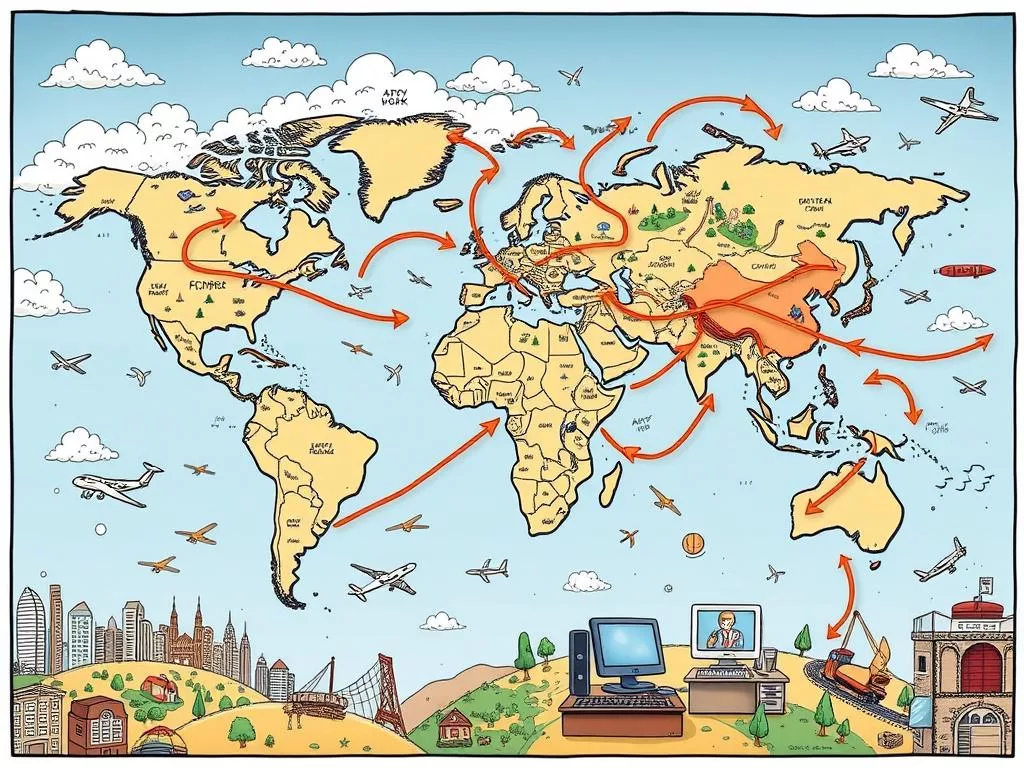Remote work has changed the workforce a lot, starting with the COVID-19 pandemic. Companies quickly moved to work from home to keep going. This big change moved work out of offices and cut down on migrant workers in jobs that needed them to be there.
Studies show that remote workers in the U.S. save about 55 minutes each day by not going to work. This helps the environment a lot. It’s good for companies and workers too. Companies save a lot of money, and 93% of workers say it’s better for their mental health.
But, the drop in migrant workers brings new problems and chances. It means fewer jobs for migrant workers in some cases. Yet, it also lets companies find talent from all over, not just locally. This shows how big of a change remote work is for jobs in the future.
Impact of Remote Work on the Workforce
Remote work has become a big part of our jobs today. Over half of workers started working from home during the pandemic in March 2020. This change is changing how businesses see productivity and keeping employees happy.
Companies are now thinking about the good and bad of remote work. They see the cost savings and the chance to hire from anywhere. But they also worry about keeping their culture alive and making sure everyone can talk to each other. About one-tenth of workers are in a mix of remote and in-person work, showing how remote work is evolving.

To really get how remote work affects work and workers, let’s dive deeper:
| Work Arrangement | Percentage of Workforce | Key Insights |
|---|---|---|
| Fully In-Person | 80% | Young people and non-college-educated individuals predominantly occupy such roles. |
| Hybrid | 10% | Equally preferred by various demographic groups, balancing office presence with remote work. |
| Fully Remote | 10% | Preferred by college-educated workers, specially women and individuals with disabilities. |
Remote work has changed things for different groups in different ways. For example, those with college degrees are more likely to work from home. On the other hand, migrant workers, who often don’t have a college degree, are less likely to work remotely.
Also, remote work shows differences in racial groups. White and Asian workers are more likely to work from home than Hispanic and Black workers. And for college-educated workers with disabilities, working from home all the time is more appealing than a mix of in-person and remote work.
In the end, remote work changes more than just how we work. It makes companies think differently about how to keep employees happy and productive. It’s changing the old ways of doing business.
Migration Trends and Geographic Mobility
The rise of remote work has changed how people move in the United States. Cities like Austin and Dallas are now attracting remote workers. These workers are looking for better living conditions and lower costs.

This shift in remote work migration is changing local economies and urban planning. It allows for more flexibility and changes the makeup of different regions. For instance, the Russian Federation saw 350,000 Tajik migrants in the first quarter of 2023.
Migration patterns show a link between economic chances and where people move. Central Asia, for example, saw a 69% increase in remittances from 2021 to 2022. This trend slightly decreased in 2023.
The impact of international migrants on host countries is significant. The Russian Federation had 6.6 million migrants from Central Asia in 2020. Remote work migration helps people move for job opportunities while staying connected online.
Migration patterns also show how many Uzbek nationals moved to Russia. This number almost doubled from 2022 to 2023.
The connection between migration trends and remote work shows how mobility affects both personal choices and broader changes. Central Asia saw 166,120 internal displacements in 2022. International student migration reached 313,000 in 2021, showing different reasons for moving.
Understanding these migration trends helps us see how remote work migration changes traditional patterns. As more people move for remote work, it can change regional economies and cultures. This shows how work and living environments are connected.
Guide to the Rise of the Remote Workers the End of the Migrant Workers
The shift to remote work has changed the traditional workforce. It has led to a decline in migrant labor as companies go digital. This guide explores these changes and offers insights for businesses to adapt.
In 2017, only 5% of employees in Latvia worked remotely, matching the European Union average. But by 2020’s second quarter, this number jumped to 18.3%. It peaked at 22% in 2021’s second half before settling at 11%. This shows how remote work is becoming more common and accepted.
Remote work is growing across Europe. The European Commission found over 40% of urban and 30% of rural employees can work remotely. Nearly three-quarters of higher-paid jobs are suitable for remote work. In Germany, a 2020 survey showed 31% of workplaces could be run from home.
This shift has big social and economic effects. Over 300,000 Latvians, or 13% of the population, have left the country. In 2020, nearly 12,000 Latvians left, followed by 13,000 in 2021, and 16,700 in 2022. Remote work is changing where people work and how they migrate digitally. For more on supporting migrant workers, visit this guide.
Remote work affects pay and where people work. It’s shaped by company policies and agreements. Businesses must stay competitive and inclusive while managing budgets. Understanding these changes is key to staying ahead in the remote work era. For more on remote work, check out this resource.

